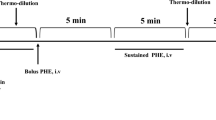Summary
To evaluate the relationship among supraventricular and ventricular arrhythmias with blood pressure and heart rate (HR) values, we studied 2 groups of 20 hypertensive men with (group I) and without (group II) left ventricular hypertrophy. Ambulatory electrocardiographic tracings were recorded continuously, together with ambulatory arterial pressure. Systolic (SBP) and diastolic (DBP) blood pressure values measured over 24 h showed no difference between the two groups, but we found greater variability in SBP in group I. The incidence of ventricular and supraventricular arrhythmias was significantly higher in patients of group I; moreover, we found a strong correlation between the incidence of ventricular extrasystoles (VPCs) and SBP, DBP, and HR values in group I, whereas in group II the incidence of supraventricular extrasystoles (APCs) was higher during peaks of SBP and HR values. The relationship between APCs and SBP observed in group II may be attributable to the pressure stimulus on a normal atrium, and the significant correlation between VPCs and SBP, DBP, and HR values may be due to episodes of subendocardial ischemia or to the influence of adrenergic stimulation on previously compromised myocardial tissue.
Similar content being viewed by others
References
Kannel WB, Doyle JT, McNamara PM, Quickenton P, Gordon T (1975) Precursors of sudden coronary death: factors related to the incidence of sudden death. Circulation 51: 606–613
Anderson KR (1982) Hypertension and sudden cardiac death. NZ Med J 95: 33–38
Devereux RB (1989) Importance of left ventricular mass as a predictor of cardiovascular morbidity in hypertension. A J Hypertens 2(8): 650–654
Messerly FH, Ventura HO, Elizardi DJ, Dunn FG, Frohlich ED (1984) Hypertension and sudden death. Increased ventricular ectopic activity in left ventricular hypertrophy. Am J Med 77: 18–21
McLenachan JM, Henderson E, Karen I, Morris BS, Henry JD (1987) Ventricular arrhythmias in patients with hypertensive left ventricular hypertrophy. N Engl J Med 317. 787–792
Levy D, Savage DD, Garrison RI (1985) The association of left hypertrophy with ventricular arrhythmias: the Framingham heart study. Circulation 72 [Suppl III]: 46 (abstract)
McLenachan JM, Dargie HJ (1989) Left ventricular hypertrophy as a factor in arrhythmias and sudden death. Am J Hypertens 2: 128–131
Mulrow JM, Michael JR, Healy MA (1986) Variability of ventricular arrhythmias in hypertrophic cardiomyopathy and implication for treatment. Am J Cardiol 58: 615–618
Novo S, Abrignani MG, Alaimo G, Corrao S, Longo B, Barbagallo M, Strano A (1989) Behaviour of ventricular arrhythmias in relation to the circadian pattern of blood pressure and left ventricular hypertrophy in patients with essential hypertension. Eur Heart J 10: 201 (abstract)
Sokolow M, Lyon TP (1949) The ventricular complex in left ventricular hypertrophy as obtained by unipolar precordial and limb leads. Am Heart J 37: 161–186
Devereux RB, Reichek N (1977) Echocardiographic determination of left ventricular mass in man: anatomic validation of the method. Circulation 55: 613–618
Novo S, Licata G, Indovina G, Immordino R, Giannola A, Sofia MA, Raineri A, Strano A (1984) Non invasive monitoring of arterial blood pressure and haemodynamic evaluation in patients suffering from complicated hypertension treated with a combination of labetalol plus chlortalidone (Rg 136). In: Labetalol plus chlortalidone in a fixed combination (RG 136): a rational approach to antihypertensive therapy. Raven Health Care Communication, New York, pp 35–41
Rembert JC, Kleinman LH, Fedor JM (1978) Myocardial blood flow distribution in concentric left ventricular hypertrophy. J Clin Invest 62: 379–386
Becker L, Pitt B (1971) Regional myocardial blood flow, ischemia and antianginal drugs. Ann Clin Res 3: 353–358
Bell JR, Fox AC (1974) Pathogenesis of subendocardial ischemia. Am J Med Sci 3: 268–267
Raab W, Lepeschkin E (1950) Biochemical versus hemodynamic factors in the origin of “hypertensive” heart disease. Acta Med Scand 138: 81–93
Corea L, Bentivoglio M, Verdecchia P (1982) Left ventricular wall thickness and plasma catecholamines in borderline and stable essential hypertension. Eur Heart J 3: 164–170
McKenna WJ, Krikler DM, Goodwin JF (1984) Arrhythmias in dilated and hypertrophic cardiomyopathy. Med Clin North Am 68: 983–1000
Author information
Authors and Affiliations
Rights and permissions
About this article
Cite this article
Novo, S., Barbagallo, M., Abrignani, M.G. et al. Cardiac arrhythmias as correlated with the circadian rhythm of arterial pressure in hypertensive subjects with and without left ventricular hypertrophy. Eur J Clin Pharmacol 39 (Suppl 1), S49–S51 (1990). https://doi.org/10.1007/BF03216278
Issue Date:
DOI: https://doi.org/10.1007/BF03216278




